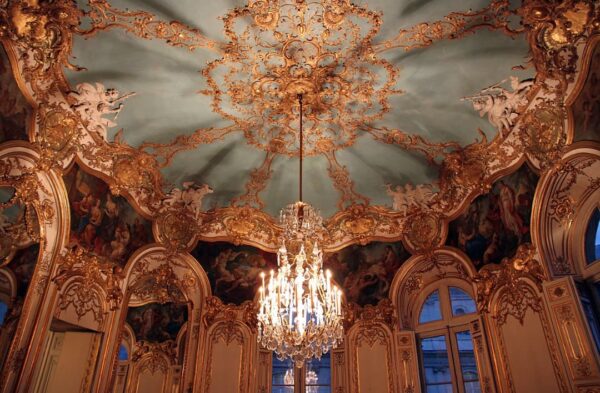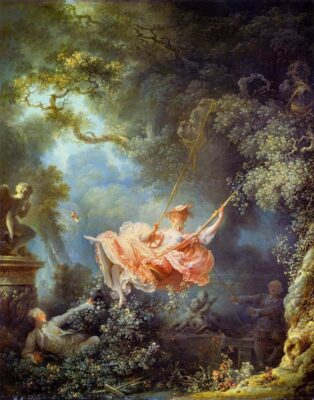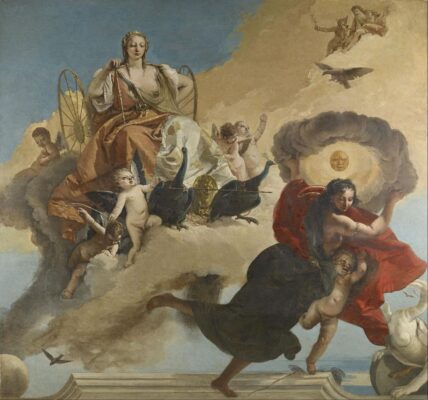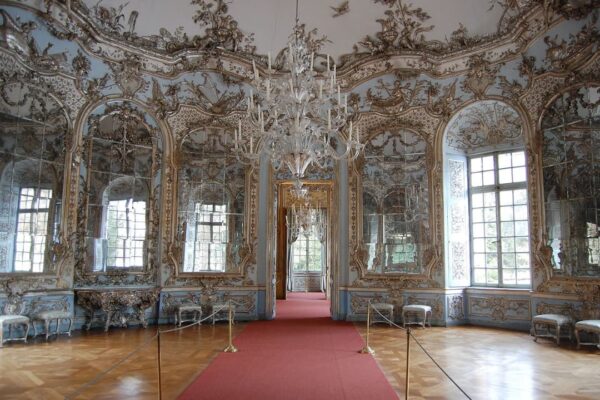Rococó
El nada discreto encanto de la burguesía
«Versalles, que había adoptado el elegante clasicismo de Girardon y luego el animado barroco de Coysevox, dio origen al nuevo estilo rococó. Así como el Barroco fue el estilo de la Iglesia Católica Romana en el siglo XVII, el Rococó fue el estilo de la corte francesa en el siglo XVIII».
Maddalena Spagnolo

Rococo – Salon de la princesse hotel de soubise

Jean Honore Fragonard – The Swing – 1767
Rococó en Francia: Salon de la princesse, en el Hôtel de Soubise, París. Fotografía de NonOmnisMoriar ·· Jean-Honoré Fragonard: «El columpio», 1767. Wallace Collection, Londres.
A la hora de iniciar esta breve presentación sobre el estilo Rococó, creo apropiado que la primera cuestión a resolver no sea buscar las características principales del movimiento, ni nombrar a sus más destacados protagonistas; ni siquiera establecer el marco temporal del mismo, sino plantear la cuestión de si existió realmente un estilo propio que podamos definir como Rococó.
Durante tiempo, el Rococó fue visto como una simple derivación (o incluso “degeneración”) del Barroco. Por ejemplo, Fiske Kimball -quien consideró tal idea «aberrante»- señala que «el Rococó ha sido normalmente interpretado como una fase tardía y extrema del barroco, algo así como el Gótico Flamígero es al Gótico» (Fiske Kimball: «Creación del Rococó», 1943), señalando como promotores de tal idea a Andreas Lindblom («El origen del Rococó», 1924) y otros muchos. Incluso algunos autores, con una visión más positiva del Rococó, no parecen proclives a considerarlo como un movimiento independiente del Barroco. «El rococó fue, en realidad, una continuación en un estilo más ligero y elegante de las tendencias ya establecidas en el barroco» (Edmund Burke Feldman: «Thinking about Art», 1985). En ese sentido, para algunos autores el Rococó no merece un reconocimiento mayor que el del Manierismo, generalmente considerado una variación tardía del estilo renacentista, si bien la naturaleza de ambos es bastante distinta, ya que mientras que el Manierismo se reveló contra varias de las características del Renacimiento, el Rococó reinterpreta y en ocasiones exagera las características del Barroco.
Uno de los problemas en el reconocimiento del Rococó es que surge después de dos periodos de colosal importancia en la historia del arte, cada uno de ellos dominando la escena artística europea durante más de un siglo: el Renacimiento y el Barroco. En contraste, el Rococó tuvo una vida más bien corta, generalmente establecida entre 1730 y 1760, y su presencia en algunos países, por ejemplo España, es prácticamente testimonial. No obstante, en Francia y zonas vecinas, desde el Norte de Italia al centro y sur de Alemania, el Rococó, durante su corta vida, tuvo una personalidad propia y unas características únicas que lo distinguen claramente del Barroco. «El rococó fue considerado una degeneración tardía del barroco, pero fue un estilo propio con características identificables«, concluye Maddalena Spagnolo («Barroco y Rococó», 2004). Entre estas características están el uso intenso de la decoración (en ocasiones con motivos orientales), las formas curvas y en ocasiones asimétricas, y –en el caso de la pintura- el gusto por los temas alegres y desenfadados, generalmente celebrando la vida feliz y desenfadada de la burguesía.
El Rococó apareció en Francia durante el reinado de Luis XV. Al contrario que el habitualmente imponente Barroco, el estilo del Rococó resultaba más apropiado para las artes decorativas y el mobiliario, donde puede, además, reflejar mejor las influencias del arte oriental, ya entonces conocido en Francia. En pintura, el iniciador del Rococó en Francia fue Antoine Watteau, cuyo estilo influyó en las obras de François Boucher y Jean-Honoré Fragonard, siendo la obra de este último plenamente rococó. La arquitectura rococó se caracteriza por el uso intenso de la ornamentación interior, y fue especialmente escogida por la nobleza y burguesía. “La arquitectura rococó es pues laica y refinada, asociada a aristócratas y emergentes burgueses, mientras que la Iglesia siguió prefiriendo el barroco clasicista (si bien en Alemania el Rococó sí transciende a lo eclesiástico).” (José Enrique García Melero: “Historia del Arte Moderno. El arte del siglo XVIII”)

Giovanni Battista Tiepolo – Juno and Luna – 1735-45

Rococo – Amalienburg Hall of mirrors
Rococó más allá de Francia: Giovanni Battista Tiepolo : «Juno y Luna», c.1735-45. Museo de Bellas Artes, Boston ·· Salón de los Espejos en el Amalienburg, Munich. Fotografía de Massimop.
En Italia, el Rococó tuvo presencia sobre todo en las ciudades del norte, con mayor influencia francesa. Destaca la figura de Giovanni Battista Tiepolo, artista muy apreciado en vida y descrito por Michael Levey como «el mejor pintor decorativo de la Europa del siglo XVIII”. En Venecia se desarrolla un género particular de pintura, la veduta, cuyos mayores representantes fueron Canaletto y Francesco Guardi, y a menudo considerada dentro del estilo Rococó.
La arquitectura alemana –y en menor medida la austriaca- fue, junto con la francesa, la que más entusiásticamente adoptó el estilo Rococó, en edificios como el Amalienburg de Múnich o el Augustusburg de Brühl. Como se ha indicado anteriormente, en Alemania el Rococó sí se traslada a algunas iglesias, como se puede observar en el interior de la Basílica de Vierzehnheiligen. En el Reino Unido, el Rococó estuvo presente en el mobiliario y las artes decorativas, como se puede observar en la obra de Thomas Chippendale o Thomas Johnson.
G. Fernández · theartwolf.com
Rococó
The not-so-discreet charm of the Bourgeoisie
“Versailles, which had subscribed to Girardon’s elegant Classicism and then to Coysevox’s lively Baroque, gave birth to the new Rococo style. Just as Baroque was the style of the Roman Catholic Church in the 17th century, Rococo was the style of the French court in the 18th century.”
Maddalena Spagnolo

Rococo – Salon de la princesse hotel de soubise

Jean Honore Fragonard – The Swing – 1767
Rococo in France: Salon de la princesse, at the Hôtel de Soubise, Paris. Photograph by NonOmnisMoriar ·· Jean-Honoré Fragonard: «The Swing», 1767. Wallace Collection, London.
At the beginning of this brief presentation on the Rococo style, I consider appropriate that the first point to be discussed is not about identifying the main characteristics of the movement, nor to name its most prominent protagonists, nor even to establish its time frame, but to raise the question of whether there really was a style of its own that we could define as Rococo.
For a long time, the Rococo was seen as a simple derivation (or even «degeneration») of the Baroque. For example, Fiske Kimball -who considered such an idea «aberrant»- pointed out that «Rococo has ordinarily been interpreted as a specific last, extreme phase of the baroque — somewhat as the Flamboyant is of the Gothic» (Fiske Kimball: «Creation of Rococo», 1943), pointing to Andreas Lindblom («The Origin of Rococo», 1924) and many others as promoters of such an idea. Even some authors, with a more positive view of the Rococo, do not seem inclined to consider it as a movement independent of the Baroque. «The Rococo was really a continuation in a lighter, more graceful, vein of tendencies already established in the Baroque» (Edmund Burke Feldman: «Thinking about Art», 1985). In that sense, for some authors the Rococo deserves no more recognition than Mannerism, generally considered a late variation of the Renaissance style, although the nature of the two is quite different, for while Mannerism went against several of the characteristics of the Renaissance, the Rococo reinterprets and sometimes exaggerates the main characteristics of the Baroque.
One of the problems in recognising the Rococo as a syle of its own is that it arose after two periods of colossal importance in the history of art, each dominating the European art scene for more than a century: the Renaissance and the Baroque. In contrast, the Rococo had a rather short life, generally established between 1730 and 1760, and its presence in some countries, for example Spain, is scarce or even nonexistent. Nevertheless, in France and neighbouring areas, from Northern Italy to central and southern Germany, the Rococo, during its short life, had its own personality and unique characteristics that clearly distinguish it from the Baroque. «Rococo was considered a late degeneration of Baroque, but it was a style in its own right with its own identifiable characteristics«, concludes Maddalena Spagnolo («Baroque and Rococo», 2004). These characteristics include the intense use of decoration (sometimes with oriental motifs), curved and sometimes asymmetrical forms, and -in the case of painting- a taste for cheerful, light-hearted themes, generally celebrating the happy, carefree life of the bourgeoisie.
Rococo appeared in France during the reign of Louis XV. In contrast to the usually imposing Baroque, the Rococo style was more suited to the decorative arts and furniture, where it could also better reflect the influences of oriental art, already known in France at the time. In painting, the initiator of Rococo in France was Antoine Watteau, whose style influenced the works of François Boucher and Jean-Honoré Fragonard, the latter’s work being fully Rococo. Rococo architecture is characterised by the intense use of interior ornamentation, and was particularly favoured by the nobility and the bourgeoisie. «Rococo architecture is therefore secular and refined, associated with aristocrats and the emerging bourgeoisie, while the Church continued to prefer the classicist Baroque (although in Germany Rococo does transcend the ecclesiastical)«. (José Enrique García Melero: «Historia del Arte Moderno. El arte del siglo XVIII»).

Giovanni Battista Tiepolo – Juno and Luna – 1735-45

Rococo – Amalienburg Hall of mirrors
Rococo beyond France: Giovanni Battista Tiepolo: «Juno and Moon», c.1735-45. Museum of Fine Arts, Boston ·· Hall of Mirrors at the Amalienburg, Munich. Photograph by Massimop.
In Italy, the Rococo style was mainly present in the northern cities, with a greater French influence. Giovanni Battista Tiepolo, an artist who was highly appreciated during his lifetime and described by Michael Levey as «the greatest decorative painter of eighteenth-century Europe», was the most prominent figure. Venice developed a particular genre of painting, the veduta, whose major representatives were Canaletto and Francesco Guardi, and which is often considered to be part of the Rococo style.
German architecture -and to a lesser extent Austrian architecture- was, along with French architecture, the most enthusiastic adopter of the Rococo style, in buildings such as the Amalienburg in Munich or the Augustusburg in Brühl. As noted above, in Germany the Rococo style can be found in some religious buildings, as can be seen in the interior of the Vierzehnheiligen Basilica. In the United Kingdom, Rococo was present in furniture and decorative arts, like in the works of Thomas Chippendale or Thomas Johnson.
G. Fernández · theartwolf.com




